warning GMC JIMMY 1997 User Guide
[x] Cancel search | Manufacturer: GMC, Model Year: 1997, Model line: JIMMY, Model: GMC JIMMY 1997Pages: 410, PDF Size: 20.03 MB
Page 137 of 410
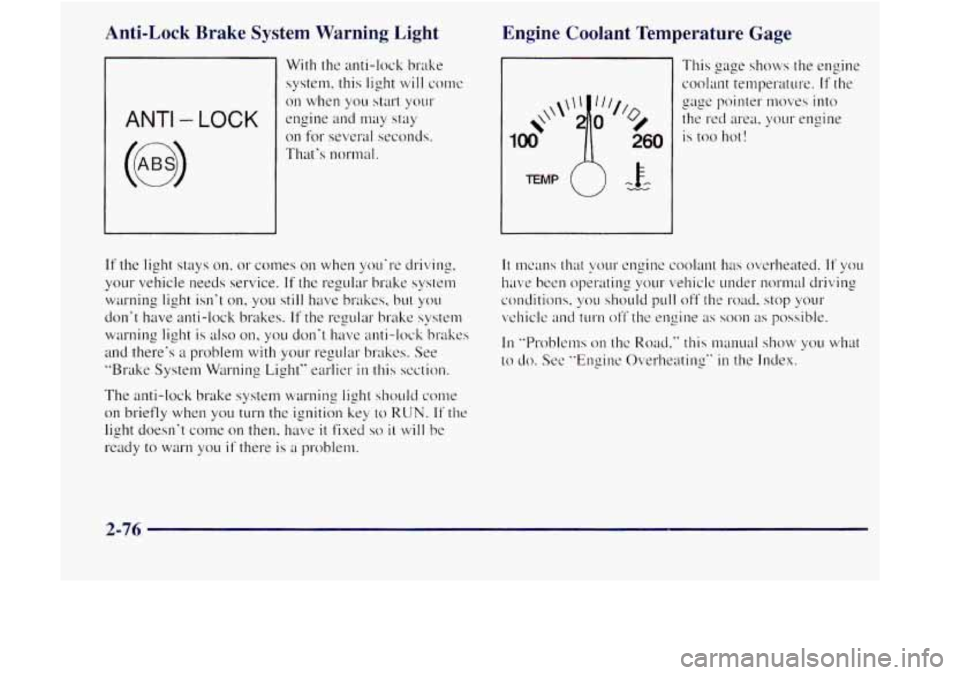
Anti-Lock Brake System Warning Light
With the anti-lock brake
system. this light
will CC)IIIC
engine and may stay
on for several seconds.
That's normal.
011 when you start y0LIr
Engine Coolant Temperature Gage
2-76
Page 172 of 410
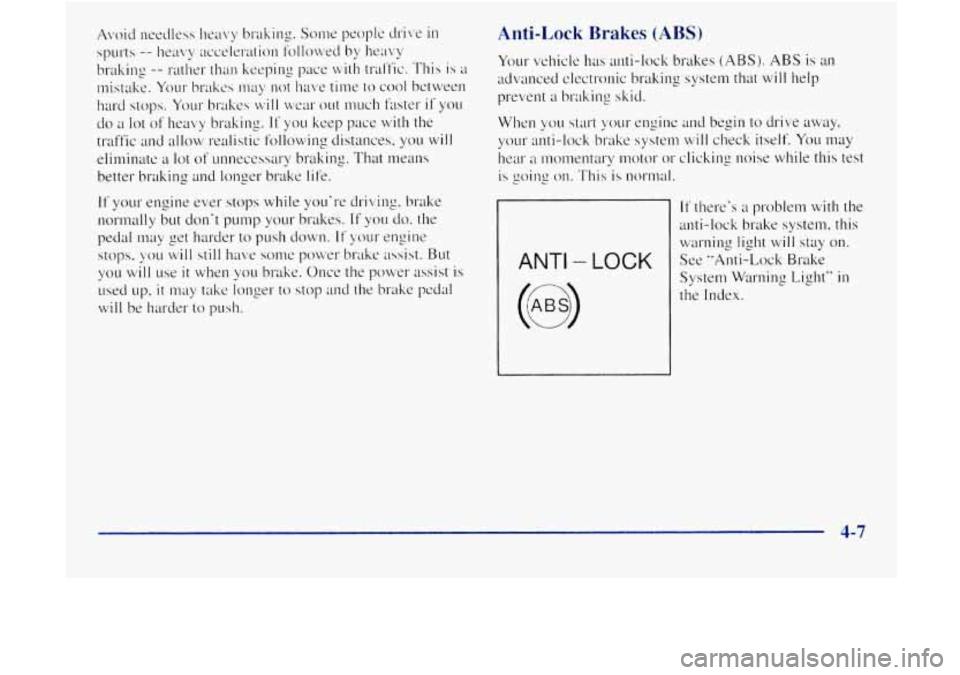
Anti-Lock Brakes (ABS)
If there’s ;1 problem with the
anti-lock
brake system. this
warning light
will stay on.
See “Anti-Lock Brake
System Warning Light”
in
the Index.
4-7
Page 179 of 410

If your vehicle starts to slide, ease your foot off the
accelerator pedal and quickly steer the way you want the
vehicle
to go. If you start steering quickly enough, your
vehicle may straighten out. Always be ready for
a
second skid if il occurs.
Of course, traction is reduced when water. snow, ice,
gravel or other material is
on the road. For safety. you'll
want to slow down
and adjust your driving to these
conditions.
It is important to slow down on slippery
surfaces because stopping distance will be longer
and
vehicle control more lilnited.
While driving
on a surface with reduced traction. try
your best to avoid sudden steering, acceleration
or
braking (inclucling engine braking by shifting to a lower
gear).
Any sudden changes could cause the tircs lo slide.
You may not realize the surface is slippery until yo11r
vehicle is skidding. Learn to recognize warning
clues
-- such as enough water. ice or packed snow on
the road to make a "mirrored surface" -- and slow down
when you
have any doubt.
Remember:
Any anti-lock brake system (ABS) helps
avoid only the braking skid.
Driving Guidelines
This multipurpose passenger vehicle is defined as a utility
vehicle in Consumer Information Regulations issued by
the National Highway Traffic Safety Administration (NHTSA)
of the United States Department of
Transportation.
Utility vehicles have higher ground
clearance
and a narrower track to make them capable of
performing
in a wide variety of off-road applications.
Specific design characteristics give them
a higher center of
gravity than ordinary cars. An advantage of the higher
ground clearance is
a better view of the road allowing yo11
to anticipate problems. They are not designed for
cornering at the same speeds
as conventional
two-wheel-drive vehicles any more than low-slung sports cars are dcsigned
to perform satisfactorily under off-road
conditions.
If at all possible. avoid shalp turns or abrupt
manewers. As with other vehicles
of this type. failure to
operate this vehicle correctly may result
in loss of control
or vehicle rollover.
4-14
Page 202 of 410
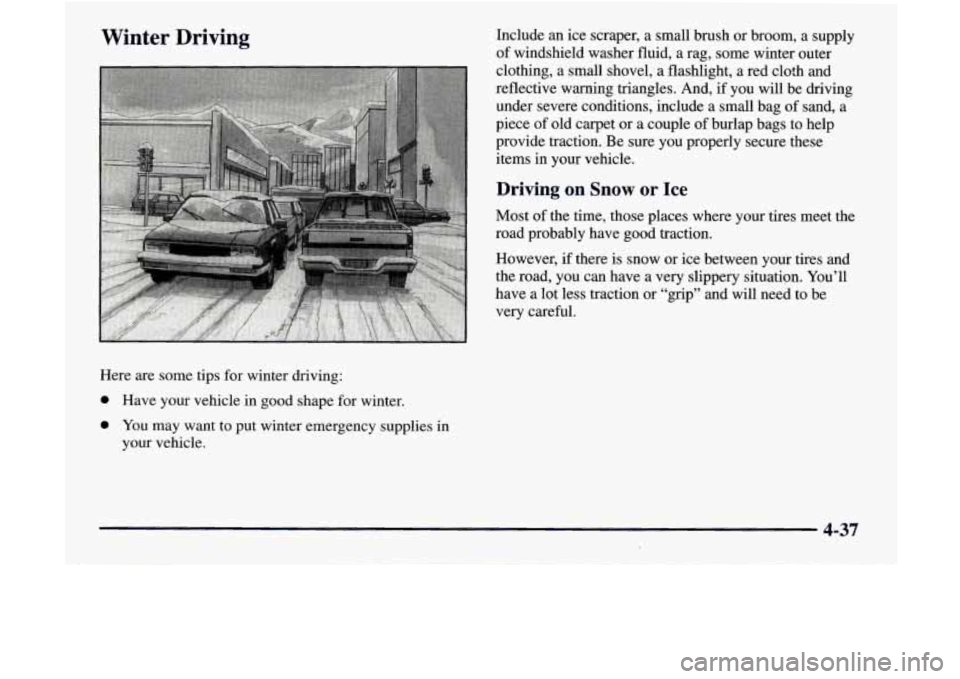
Winter Driving
Here are some tips for winter driving:
0 Have your vehicle in good shape for winter.
0 You may want to put winter emergency supplies in
your vehicle. Include an ice scraper, a small brush or broom, a supply
of windshield washer fluid,
a rag, some winter outer
clothing, a small shovel, a flashlight, a red cloth and
reflective warning triangles. And, if you will be driving
under severe conditions, include a small bag
of sand, a
piece
of old carpet or a couple of burlap bags to help
provide traction. Be sure you properly secure these
items in your vehicle.
Driving on Snow or Ice
Most of the time, those places where your tires meet the
road probably have good traction.
However, if there is snow or ice between your tires and
the road, you can have a very slippery situation. You’ll
have a lot less traction or “grip” and will need to be
very careful.
4-37
Page 217 of 410
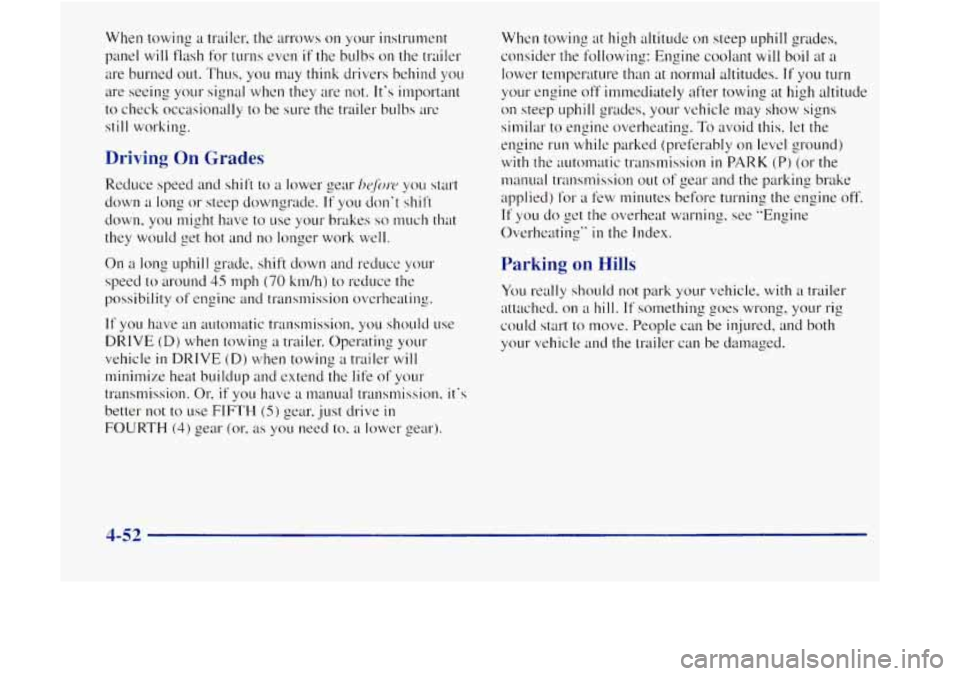
When towing a trailer, the ~~rrows on your instrument
panel
will flash for turns even if the bulbs on the trailer
itre burned out. Thus. you may think drivers behind you
are seeing your signal when they are not. It's important
to check occasionally to be sure the trailer bulbs arc
still working.
Driving On Grades
On a long uphill grade, shift down and reducc your
speed
to around 45 mph (70 km/h) to reduce the
possibility
of engine and transmission ovc.rheating.
If you have an automatic transmission. you should use
DRIVE
(D) when towing a trailer. Operating your
vehicle
in DRIVE (D) when towing a trailer will
minimize heat buildup and extend the life
of your
trrmsmission. Or:
if you have ;1 manual transmission. it's
better not to use FIFTH (5) gear. just drive in
FOURTH (4) gear (or, as you need to, a I~MW gear). Whcn
towins at high altitude
on steep uphill grades,
consider the following: Engine coolant will boil at a
lower temperature than at normal altitudes. If yo^^ turn
your engine off immediately after towing
at high altitude
on steep uphill grades, your \:ellicle may show signs
similar to engine overheating.
To avoid this. let the
engine
r~~n while parked (preferably on level grout1d)
with the automatic transmission in PARK (Pj (or the
1manuaI transmission out of
gear and the parking brake
applied) 1'01-
;I few minutes before turning the engine off.
If you do get the overheat warning. see "Engine
Overheating"
in the Index.
Parking on Hills
You really should not park your vehicle. with a trailer
attached.
on a hill. If something goes wrong, your rig
could start
to move. People can be injured, and both
yo~~r vehicle and the trailer can
be damaged.
4-52
Page 223 of 410

Hazard Warning Flashers
Other Warning Devices
5-2
Page 234 of 410

If No Steam Is Coming From Your Engine
If you zet the overheat warning but see or hear no
steam. the problem may not be too serious. Sometimes
the engine can get
a little too hot when you:
0 Climb a long hill on a hot day.
Stop after high-speed driving.
Idle for long periods in traffic.
Tow a trailer. See "Driving on Grades" in the Index.
If you get the overheat warning with no sign of steam,
try this for a minute
or so:
2. T~11-11 on yo~~r heater to full hot at the highest fan
speed and open the window as necessary.
3. If you're in a traffic jam. shift to NEUTRAL (N):
otherwise, shift to the highest gear \vhile
driving -- AUTOMATIC OVERDRIVE ((33) or
DRIVE (D) for automatic transmissions.
If you no longer have the overheat warning. you
can drive. Just
to be safe. drive slower for about
10 minutes. If the warning doesn't come back on.
you can drive norrnally.
If the warning continues. pull over, stop, and park your
vehicle right away.
If there's still no sign of steam. push the accelerator until
the engine speed is about twice as fast as normal idle
speed. Bring the engine speed back
to normal idle speed
after two or three minutes. Now see
if the warning stops.
But then, if you still have the warning, rum ogtlw
eugine
c~l got el?er;\.olw out oftlw \vl~iclc. until it
cools down.
You
may decide not to lift the hood but to get service
help right
away.
5-13
Page 237 of 410
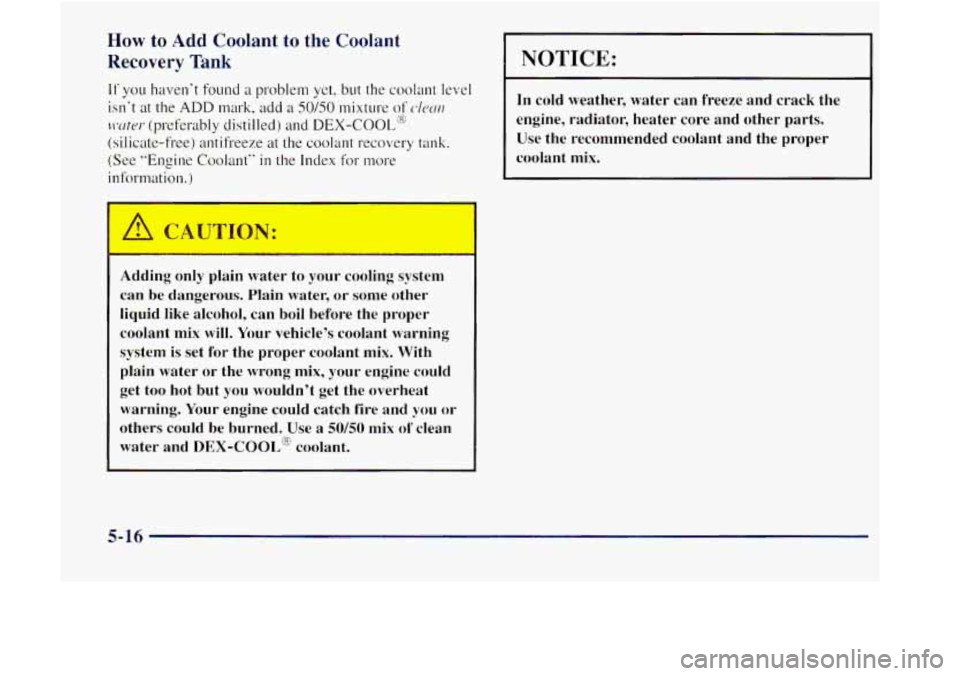
How to Add Coolant to the Coolant
Recovery Tank
If you haven't found a problem yet, but the coolant level
isn't at the
ADD mark, add a SO/SO mixture of d~ctrz
,twtur (preferably distilled) and DEX-COOL'@
(silicate-free) antifreeze at the coolant recovery tank.
(See "Engine Coolant" in the Index for more
information.
)
_s I
Adding only plain water to your cooling system
can be dangerous. Plain water, or some other
liquid like alcohol, can boil before the proper
coolant mix
will. Your vehicle's coolant warning
system is set for the proper coolant mix. With
plain water or the wrong mix, your engine could
get too hot but you wouldn't get the overheat
warning. Your engine could catch fire and you or
others could be burned. Use
a 50/50 mix of clean
water and
DEX-COOL" coolant.
NOTICE:
In cold weather, water can freeze and crack the
engine, radiator, heater core and other parts. Use the recommended coolant and the proper
coolant mix.
5-16
Page 244 of 410

Changing a Flat Tire
If a tire goes flat, avoid further tire and wheel damage
by driving slowly to a level place. Turn on your hazard
warning flashers.
A CAUTION:
Changing a tire can cause an injury. The vehicle
can slip off the jack and roll over you or other
people. You and they could be badly injured.
Find a level place to change your tire.
To help
prevent the vehicle from moving:
1. Set the parking brake firmly.
2. Put an automatic transmission shift
lever in PARK
(P) or shift a manual
transmission to FIRST
(1) or
REVERSE (R).
CAUTIQN: iContinued) .~
3. If you have a four-wheel-drive vehicle
with a manual transfer case shift lever,
be sure the transfer case is in a drive
gear
-- not in NEUTRAL (N).
4. Turn off the engine.
5. Put the wheel blocks at the front and
rear
of the tire farthest away from the
one being changed. That would be the
tire on the other side of the vehicle,
at
the opposite end.
5-23
Page 282 of 410
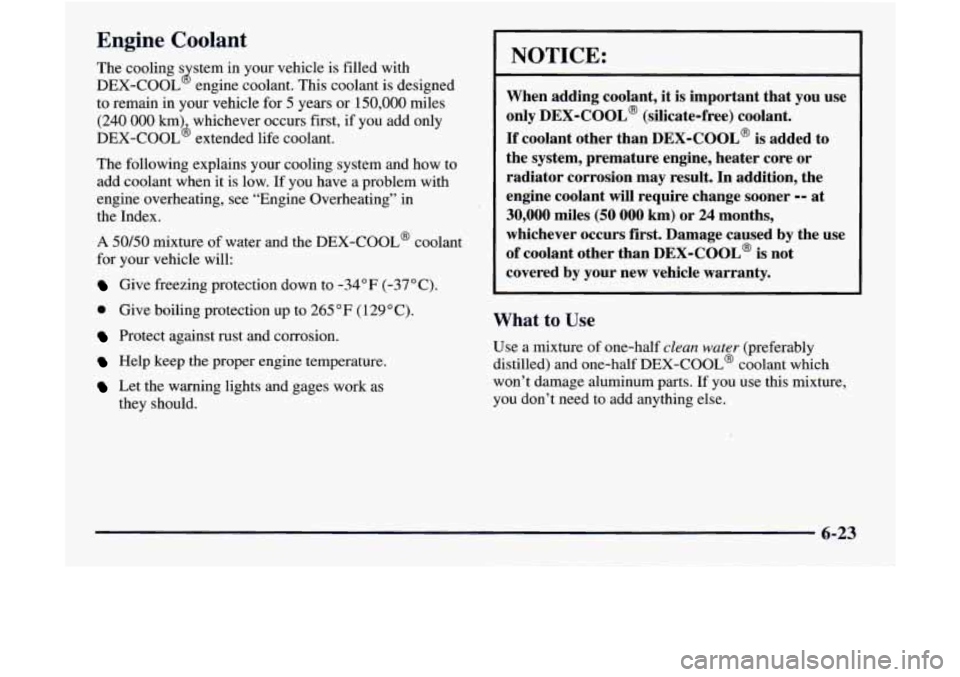
Engine Coolant
The cooling s stem in your vehicle is filled with
DEX-COOL engine coolant. This coolant is designed
to remain in your vehicle
for 5 years or 150,000 miles
(240 000 km) whichever occurs first, if you add only
DEX-COOL’ extended life coolant.
The following explains your cooling system and how to
add coolant when it is low. If you have a problem with
engine overheating, see “Engine Overheating” in
the Index.
A 50/50 mixture of water and the DEX-COOL@ coolant
for your vehicle will:
Give freezing protection down to -34°F (-37°C).
0 Give boiling protection up to 265 OF ( 129 O C).
Protect against rust and corrosion.
Help keep the proper engine temperature.
Let the warning lights and gages work as
8
they should.
NOTICE:
When .adding coolant, it is important that you use
only
DEX-COOL@ (silicate-free) coolant.
If coolant other than DEX-COOL@ is added to
the system, premature engine, heater core
or
radiator corrosion may result. In addition, the
engine coolant will require change sooner
-- at
30,000 miles (50 000 km) or 24 months,
whichever occurs
first. Damage caused by the use
of coolant other than DEX-COOL@ is not
covered by your new vehicle warranty.
What to Use
Use a mixture of one-half clean water (preferably
distilled) and one-half DEX-COOL@ coolant which
won’t damage aluminum parts. If you use this mixture,
you don’t need to add anything else.
6-23